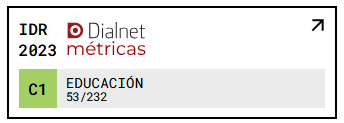Incidencia y prevalencia de los factores de riesgo en el desarrollo
DOI:
https://doi.org/10.18172/con.579Keywords:
Risk infants, early development, risk factors, early interventionAbstract
The aim of this study was to evaluate the incidence and prevalence of developmental risk factors in the population of La Rioja, in order to compare these data with other studies and identify the needs of early intervention in the region. Data on all infant born between January 1998 and December 2003 (inclusive) in La Rioja were included and considered in this study. Risk factors (pre, peri or postnatal) for unfavourable outcomes were studied in this group, as well as the time of diagnosis. Incidence and prevalence data and statistical differences between early or delayed diagnosis were estimated with the SPSS program. Results show: a) an increase in birthrate; b) risk prevalence was within the 3.51- 4.73 % range; c) an increasing rate of preterm births was found in this population; and d) finally, most risk newborns were identified at an early age, mainly in the first six months of life (71.52% of them in the neonatal period), with significant year-on-year differences. The knowledge of risk situations and their early detection allow to establish programs focused on children and families in order to ameliorate developmental courses.Downloads
References
Arizcun, J. (2002). Aspectos neonatológicos y factores de riesgo en atención temprana. Revista de Neurología, 34(1), 136-182.
Blackman, J. A. (2002). Early Intervention: A Global Perspective. Infants & Young Children, 15(2), 11-19.
Cambrodí, A. (1983). Principios de Psicología Evolutiva del Deficiente Mental. Barcelona: Herder.
De Haan, M. y Johnson, M. (2003). The cognitive Neurosicence of Development. New York, NY: Psychology Press.
Della Piazza, S. (1997). L’enfant prematuré: le point sur la question. Bruxelles: De Boeck Université.
Diamond, A. (2002). Normal development of prefrontal cortex from birth to young adulthood: Cognitive functions, anatomy and biochemistry. En D.T. Stuss y R.T. Knighte (eds.), Principles of Frontal Lobe Function (pp. 466-503). London: Oxford University Press.
Doyle, L. (2001). Outcome at 5 years of age of children 23 to 27 weeks’gestation: refining the prognosis. Pediatrics, 108(1), 134-141.
Elgen, I., Sommerfelt, K., Ellersten, B. (2003). Cognitive performance in a low birth weight cohort at 5 and 11 years of age. Pediatric Neurology, 28(3), 1-6.
Elster, N. (2000). Less is more: the risk of multiple births. Fertility and Esterility, 74(4), 617-623.
Escobar, G. J., Littenberg, B., Petiti, D. B. (1991). Outcome among surviving very low birth weight infants: A meta-analysis. Archives of Disease in Childhood, 66, 204-211.
Farley, T. A., Mason, K., Rice, J., Habel, J. D., Scribner, R. y Cohen, D. A. (2006). The relationship between the neighbourhood environment and adverse birth outcomes. Paediatric & Perinatal Epidemiology, 20(3), 188-200.
Figueras Aloy, J. (2004). Coordinación interdisciplinaria de la atención al recién nacido de alto riesgo. Propuestas de actuación. Boletín de Pediatría, 44, 182-184.
García-Sánchez, F. A., Caballero, P. A. y Castellanos, P. (1996). Características físicas y psicomotoras, modalidades de tratamiento y escolarización en distintos tipos de parálisis cerebral infantil en la región de Murcia. Anales de Pedagogía, 12, 175-193.
Gardner, J. M., Walker, S. P., Powell, C. A., y Grantham-McGregor, S. (2003). A randomized controlled trial of a home-visiting intervention on cognition and behavior in term low birth weight infants. Journal of Pediatrics, 143(5), 634-639.
Guralnick, M. J. (1993). Second generation research on the effectiveness of early intervention. Early Education and Development, 4, 366-378.
Grupo de Atención Temprana (2000). Libro blanco de la Atención Temprana. Madrid: Real Patronato de Prevención y de Atención a Personas con Minusvalía. Recuperado de http://paidos.rediris.es/gat/2000.htm.
Hill, J. L., Brooks-Gunn, J., y Waldfogel, J. (2003). Sustained effects of high participation in an early intervention for low-birth-weight premature infants. Developmental Psychology, 39(4), 730-44.
Karmiloff-Smith, A. (1997). Promissory notes, genetic clocks, and epigenetic outcomes. Behavioral and Brain Sciences, 20(2), 355-360.
Lumley, J. (2003). Defining the problem: the epidemiology of preterm birth. BJOG: an International Journal and Obstetrics and Gynaecology, 110(20), 3-7.
McCormick, M. C., Brooks-Gunn, J., Buka, S. L., Goldman, J., Yu, J., Salganik, M., Scott, D. T., Bennett, F. C., Kay, L.L., Bernbaum, J. C., Bauer, C. R., Martin, C., Woods, E. R., Martin, A. y Casey, P. H. (2006). Early intervention in low birth weight premature infants: results at 18 years of age for the Infant Health and Development Program. Pediatrics, 117(3), 771-780.
Mellier, D. y Fessard, C. (1998). Preterm birth and cognitive inhibition. European Review of Applied Psychology, 48, 13-18.
Mikkola, K., Ritari, N., Tommiska, V., Salokorpi, T., Lehtonen, L., Tammela, O., Paakkonen, L., Olsen, P., Korkman, M., y Fellman, V. (2005). Neurodevelopmental outcome at 5 years of age of a national cohort of extremely low birth weight infants who were born in 1996-1997.
Pediatrics, 116(6), 1391-1400.
Mounoud, P. (1996). Perspective taking and belief attribution. From Piaget´s theory to children´s theory of mind. Swiss Journal of Psychology. 55(2), 93-103.
Munakata, Y., Casey, B. J. y Diamond, A. (2004). Developmental cognitive neuroscience: progress and potential. TRENDS in Cognitive Sciences, 8(3), 122-128.
Olds, D. (2006). Progress in Improving the Development of Low Birth Weight Newborns. Pediatrics, 117(3), 940-941.
Organización Mundial de la Salud (2006). Informe sobre la salud en el mundo. Recuperado de http://www.who.int/whr/es/index.html.
Pallás Alonso, C. R. (2004). El recién nacido menor de 1.500 g y la discapacidad. Boletín de Pediatría, 44, 193-197.
Perlman, J. (2001). Neurobehavioral deficits in premature graduates of intensive care potential medical and neonatal environmental risk factors. Pediatrics, 108(6), 1339-1347.
Plomin, R. y Petrill, S. (1997). Genetics and intelligence: What’s new? Intelligence, 24(1), 53-77.
Poch, M. L., Sastre, S., Merino, N., Escolano, E., Farriol, R., y Gil, J. (2003). Unidades de seguimiento del desarrollo. Revista de Atención Temprana, 6(1), 23-28.
Programa Helios I (1996). Intervention precoce. Information, orientation et guidance des famillas. Recuperado de http://paidos.rediris.es/genysi/recursos/doc/leyes/guia_bpr.htm.
Programa Helios II (1996). Prevención, detección temprana, intervención e integración. Recuperado de http://paidos.rediris.es/genysi/recursos/doc/leyes/heliosii.htm.
Quartz, S. R. y Sejnowski, T. J. (1997). The neural basis of cognitive development: A constructivist manifest. Behavioral and Brain Sciences, 20, 537-596.
Ramos, I., Marquez, A. y Lluch, M. D. (1992). Control psiconeuroevolutivo de recién nacidos de alto riesgo. Anales Españoles de Pediatría, 35, 313-318.
Sastre, S. y Poch, M. L. (2001). Prevención e intervención en el desarrollo cognitivo Temprano. Revista de Salud y Servicios Sociales, 64, 9-11.
Sociedad Española de Neonatología (2001). Recomendaciones de mínimos para la asistencia del recién nacido sano. Recuperado de http://www.se-neonatal.es/default_principal.asp?idx=&cidioma=2.
Sommerfelt, K., Andersson, H. W., Sonnander, K., Ahlsten, G ., Ellertsen, B., Markestad, T., Jacobsen, G., Hoffman, H. J. y Bakketeig, L. (2000). Cognitive development of term small for gestational age children at five years of age. Archives of Disease in Childhood, 83, 25-30.
Sonnander, K. (2000). Early identification of developmental disabilities Acta Paediatrica, 89(Suppl. 434), 17-23.
Stanton-Chapman, T. L., Chapman, D. A., Bainbridge, N. L. y Scott, K. G. (2002). Identification of early risk.factors for language impairment. Research in Developmental Dissabilities, 23(6), 390-405.
Thompson, J. M. D., Irgens, L. M., Rasmussen, S., Daltveit, A. K. (2006). Secular trends in socio-economic status and the implications for preterm birth. Paediatric and Perinatal Epidemiology, 20(3), 182-187.
Topp, M., Huusom, L. D., Langhoff-Roos, J., Delhumeau, C., Hutton, J. L. y Dolk , H. (2004). Multiple birth and cerebral palsy in Europe: a multicenter study. Acta Obstetricia et Gynecologica Scandinavica, 83(6), 548-53.
Valle Trapero, M. (2002). Intervención precoz en niños de alto riesgo biológico. Tesis Doctoral. Universidad Complutense de Madrid. Recuperado de http://www.ucm.es/eprints/2236/.
Valle Trapero, M. (1999). La función de la familia en el niño hospitalizado. Revista Latinoamericana de Neonatología, 1, 111-113.
van Baar, A. L., van Wassenaer, A. G., Briet, J. M., Dekker, F. W. y Kok, J. H. (2005).Very Preterm Birth is Associated with Disabilities in Multiple Developmental Domains. Journal of Pediatric Psychology, 30(3), 247-255.
van den Oord, E. J., Boomsma, D. I. y Verhulst, F. C. (2000). Study of Genetic and Environmental Effects on the Co-Occurrence of Problem Behaviors in Three-Year-Old Twins. Journal of Abnormal Psychology, 109, 360-372.
Ward, R. M. y Beachy, J. C. (2003). Neonatal complications following preterm birth. BJOG: an International Journal of Obstetrics and Gynaecology, 110(20), 8-16.
Wolke, D. (2005). Desarrollo psicológico a largo plazo de los niños muy pretérmino y otros de riesgo neonatal. Recuperado de http://paidos.rediris.es/genysi/recursos.htm.
Downloads
Published
How to Cite
Issue
Section
License
The authors retain copyright of articles and authorize Contextos Educativos. Revista de Educación the first publication. They are free to share and redistribute the article without obtaining permission from the publisher as long as they give appropriate credit to the editor and the journal.
Self-archiving is allowed too. In fact, it is recommendable to deposit a PDF version of the paper in academic and/or institutional repositories.












